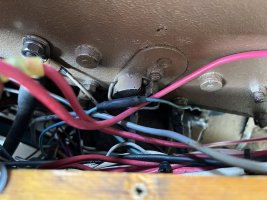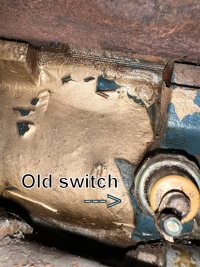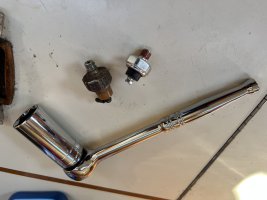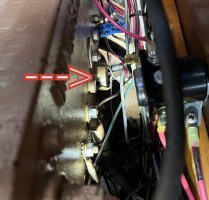Yacht cockpit instrument panels often have a buzzer that goes off when the ignition is turned on, then goes quiet as soon as the engine starts. The buzzer is wired to an oil pressure switch screwed into the engine oil reservoir. When the key is turned on, but before the engine starts, there's not yet any oil pressure. So, buzz! When the engine starts, rising oil pressure turns the buzzer off.

The oil pressure switch is a critical component designed to sound any time oil pressure falls. To hear that sound under power means shutting the engine down immediately, since running a motor without oil is catastrophic. It also reminds you to turn off the ignition after a diesel is shut down.
My warning buzzer/light started buzzing intermittently, or buzzing at cruise speed when temperature and oil levels were normal. Why? Because they wear out, or the wire to the buzzer breaks.
Troubleshooting is simply to take the wire off the switch and touch it to the engine, thereby grounding it. A working buzzer will buzz because the switch is normally "off" (not grounded) and only goes "on" if the switch identifies low oil pressure and closes the circuit.

There is widespread confusion about the difference between switches and sensors. Switches operate "idiot" lights and buzzers. Sensors operate gauges and give more information to analog dials or digital readouts. Sensors and switches are not interchangeable. Identification is muddied by Universal Westerbeke manuals (engines can have switches or sensors, or both, or neither) as well as casual sources. (A switch does "sense" change, but that doesn't make it a sensor.)
I learned all of that from our learned colleagues in this thread. I learned how to change the oil pressure switch on the Ericson 381 all by myself, thank you.
Alas, on my model the oil pressure switch is very nearly inaccessible. It is on the starboard side of the engine, under the starter motor, recessed beneath the manifold. It cannot be seen except by a mirror on a stick. It cannot be grasped firmly by a human hand. No inspection port can be installed for better access.
 ...
...
Blue wire leads to hidden switch.
Here are E381 installation notes, written in blood:
I ordered "Oil Pressure Switch for Kubota V1500, V1501 etc." Little information is available as to PSI, whether Imperial or Metric, or wrench size. I took this recommendation from a 5432 diesel owner online, and it does fit. The new switch takes a 24mm deep socket wrench.
I used two physical approaches, the first from the quarterberth, with its limited inspection hatches:
Detach the wire from the existing switch. It is probably not possible to unscrew the wire after 35 years, so cut it. The only wrench that will work to remove the switch is a deep socket--no pliers or spanner or adjustable will fit, and a standard socket is too shallow. But what size deep socket? My new switch takes a 24mm socket. However, I discovered that the existing switch took a 27mm socket. Since you can't see or measure the existing switch, guessing the correct socket took two separate trips to OReilly Auto Parts.

Once the right socket is obtained, patience is required. A human hand and the wrench handle cannot fit in the access space simultaneously. Find the switch with a hand, work the deep socket over it, and then connect the wrench handle. The throw will be 1/6 turn, with about 50 turns required. When the old switch comes out, oil will not pour out of the engine block (but don't start the engine).
The new switch cannot be screwed in from the quarterberth position because the human hand cannot reach under the starter the way a socket can.
So: Switch access to the transmission area. To be able to reach the switch I removed the engine exhaust hose and the waterlift muffler, and uncoupled the heat exchanger from its mount so it could be hauled and lashed away to one side. Entry into the lazarette is facing forward, feet to the stern, so the forehead can rest on a towel on the engine block. Bring the new switch, detached from its wire.
Spread a towel next to the engine in case anything gets dropped, because the bilge there is unforgiving and will swallow up the new switch, which took a week to arrive. With switch in left hand, find the recessed 3/8th" hole on the engine block and hand-screw in the switch. This took me an hour, groping and turning with fingertips. It is hard to judge orientation blind, the body position is awkward and uncomfortable, but it can be done.
The socket wrench cannot be used from this access, so return to the quarterberth position. Insert the correct wrench for the new switch and tighten it.
Now the wire must be attached to the end of the switch using its tiny, one-only screw. However, this cannot be done from the quarterberth position, so return to the transmission access position again.
Place the screw in the ring connector of the wire and seat the screw into the switch. Yes, fingertips only, blind and by feel, but it can be done. Do not drop the screw as it is an odd metric size for which I did not have one match in my vast collection of such things. Once seated, a stub screwdriver can tighten it home.
Turn on the ignition. It buzzes.
Start the engine. Buzzing stops.
Was all the awkwardness, week-long search for tools, contortions and doubt worth it? Well, I can't imagine asking a boat mechanic to do this job. They would just say, no thanks. Or they would say, "we'll have to lift the engine because you can't reach that part." And they'd be pretty close to right.
I'll bet the 381, and probably the 38, are the only models where the oil pressure switch is so inconveniently located. Just depends on the furniture and the installation. If there's a lesson here it's that if I can do it, anybody can. And when it needs to be done, there really isn't an obvious alternative.
Indexed as a Blog entry here.

The oil pressure switch is a critical component designed to sound any time oil pressure falls. To hear that sound under power means shutting the engine down immediately, since running a motor without oil is catastrophic. It also reminds you to turn off the ignition after a diesel is shut down.
My warning buzzer/light started buzzing intermittently, or buzzing at cruise speed when temperature and oil levels were normal. Why? Because they wear out, or the wire to the buzzer breaks.
Troubleshooting is simply to take the wire off the switch and touch it to the engine, thereby grounding it. A working buzzer will buzz because the switch is normally "off" (not grounded) and only goes "on" if the switch identifies low oil pressure and closes the circuit.

There is widespread confusion about the difference between switches and sensors. Switches operate "idiot" lights and buzzers. Sensors operate gauges and give more information to analog dials or digital readouts. Sensors and switches are not interchangeable. Identification is muddied by Universal Westerbeke manuals (engines can have switches or sensors, or both, or neither) as well as casual sources. (A switch does "sense" change, but that doesn't make it a sensor.)
I learned all of that from our learned colleagues in this thread. I learned how to change the oil pressure switch on the Ericson 381 all by myself, thank you.
Alas, on my model the oil pressure switch is very nearly inaccessible. It is on the starboard side of the engine, under the starter motor, recessed beneath the manifold. It cannot be seen except by a mirror on a stick. It cannot be grasped firmly by a human hand. No inspection port can be installed for better access.
 ...
...
Blue wire leads to hidden switch.
Here are E381 installation notes, written in blood:
I ordered "Oil Pressure Switch for Kubota V1500, V1501 etc." Little information is available as to PSI, whether Imperial or Metric, or wrench size. I took this recommendation from a 5432 diesel owner online, and it does fit. The new switch takes a 24mm deep socket wrench.
I used two physical approaches, the first from the quarterberth, with its limited inspection hatches:
Detach the wire from the existing switch. It is probably not possible to unscrew the wire after 35 years, so cut it. The only wrench that will work to remove the switch is a deep socket--no pliers or spanner or adjustable will fit, and a standard socket is too shallow. But what size deep socket? My new switch takes a 24mm socket. However, I discovered that the existing switch took a 27mm socket. Since you can't see or measure the existing switch, guessing the correct socket took two separate trips to OReilly Auto Parts.

Once the right socket is obtained, patience is required. A human hand and the wrench handle cannot fit in the access space simultaneously. Find the switch with a hand, work the deep socket over it, and then connect the wrench handle. The throw will be 1/6 turn, with about 50 turns required. When the old switch comes out, oil will not pour out of the engine block (but don't start the engine).
The new switch cannot be screwed in from the quarterberth position because the human hand cannot reach under the starter the way a socket can.
So: Switch access to the transmission area. To be able to reach the switch I removed the engine exhaust hose and the waterlift muffler, and uncoupled the heat exchanger from its mount so it could be hauled and lashed away to one side. Entry into the lazarette is facing forward, feet to the stern, so the forehead can rest on a towel on the engine block. Bring the new switch, detached from its wire.
Spread a towel next to the engine in case anything gets dropped, because the bilge there is unforgiving and will swallow up the new switch, which took a week to arrive. With switch in left hand, find the recessed 3/8th" hole on the engine block and hand-screw in the switch. This took me an hour, groping and turning with fingertips. It is hard to judge orientation blind, the body position is awkward and uncomfortable, but it can be done.
The socket wrench cannot be used from this access, so return to the quarterberth position. Insert the correct wrench for the new switch and tighten it.
Now the wire must be attached to the end of the switch using its tiny, one-only screw. However, this cannot be done from the quarterberth position, so return to the transmission access position again.
Place the screw in the ring connector of the wire and seat the screw into the switch. Yes, fingertips only, blind and by feel, but it can be done. Do not drop the screw as it is an odd metric size for which I did not have one match in my vast collection of such things. Once seated, a stub screwdriver can tighten it home.
Turn on the ignition. It buzzes.
Start the engine. Buzzing stops.
Was all the awkwardness, week-long search for tools, contortions and doubt worth it? Well, I can't imagine asking a boat mechanic to do this job. They would just say, no thanks. Or they would say, "we'll have to lift the engine because you can't reach that part." And they'd be pretty close to right.
I'll bet the 381, and probably the 38, are the only models where the oil pressure switch is so inconveniently located. Just depends on the furniture and the installation. If there's a lesson here it's that if I can do it, anybody can. And when it needs to be done, there really isn't an obvious alternative.
Indexed as a Blog entry here.
Last edited:

